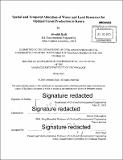| dc.contributor.advisor | Dennis McLaughlin | en_US |
| dc.contributor.author | Xydi, Afroditi | en_US |
| dc.contributor.other | Massachusetts Institute of Technology. Department of Civil and Environmental Engineering. | en_US |
| dc.coverage.spatial | f-ke--- | en_US |
| dc.date.accessioned | 2015-10-30T19:01:27Z | |
| dc.date.available | 2015-10-30T19:01:27Z | |
| dc.date.copyright | 2015 | en_US |
| dc.date.issued | 2015 | en_US |
| dc.identifier.uri | http://hdl.handle.net/1721.1/99620 | |
| dc.description | Thesis: M. Eng., Massachusetts Institute of Technology, Department of Civil and Environmental Engineering, 2015. | en_US |
| dc.description | Cataloged from PDF version of thesis. | en_US |
| dc.description | Includes bibliographical references (pages 135-142). | en_US |
| dc.description.abstract | As the population of the world increases, food security becomes a more pressing issue. This is especially true for Kenya. The country's population is increasing at a very fast rate and food production has not been able to keep up with the increasing population. This analysis assesses Kenya's ability to feed its own people by modelling the potential for increasing the production of cereals, specifically maize, wheat and rice, which together amount to approximately half the calories in the average Kenyan diet. To determine the spatial and temporal allocation of land and water resources for the optimal calories produced by maize, wheat and rice two optimization models were used. The first optimization is a least squared estimation used to calibrate the model and reproduce current conditions. The second optimization maximizes total calories produced for wheat, maize and rice, while being constrained by a water balance and land availability given soil suitability for each crop. The results of this analysis reveal that Kenya has a very large potential to increase its cereal production mainly on the western and southern part of the country. Approximately half the water for these crops comes from irrigation. As production increases, the flow in the river decreases, and groundwater use increase. The conclusion of this paper is that Kenya has the potential to increase its calorie production of cereals by at least a factor of 5. | en_US |
| dc.description.statementofresponsibility | by Afroditi Xydi. | en_US |
| dc.format.extent | 180 pages | en_US |
| dc.language.iso | eng | en_US |
| dc.publisher | Massachusetts Institute of Technology | en_US |
| dc.rights | M.I.T. theses are protected by copyright. They may be viewed from this source for any purpose, but reproduction or distribution in any format is prohibited without written permission. See provided URL for inquiries about permission. | en_US |
| dc.rights.uri | http://dspace.mit.edu/handle/1721.1/7582 | en_US |
| dc.subject | Civil and Environmental Engineering. | en_US |
| dc.title | Spatial and temporal Allocation of water and Land Resources for optimal cereal production in Kenya | en_US |
| dc.type | Thesis | en_US |
| dc.description.degree | M. Eng. | en_US |
| dc.contributor.department | Massachusetts Institute of Technology. Department of Civil and Environmental Engineering | |
| dc.identifier.oclc | 926710080 | en_US |
